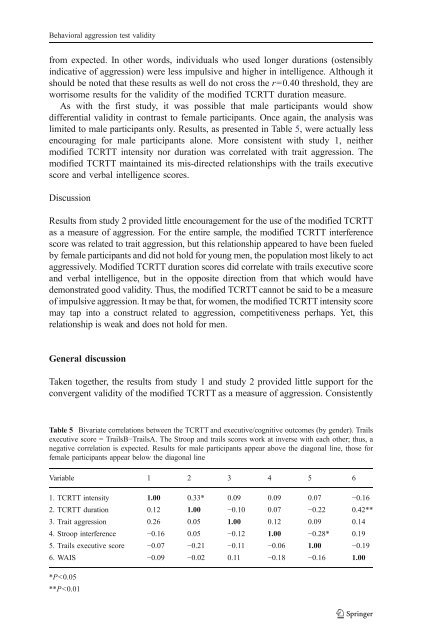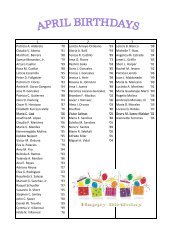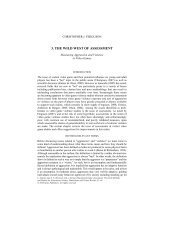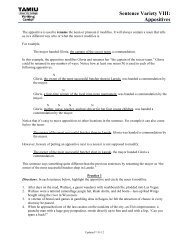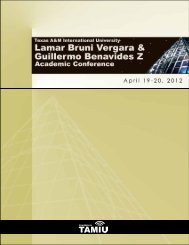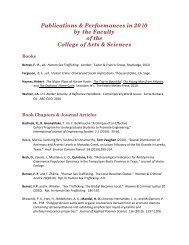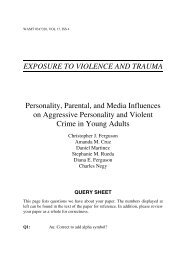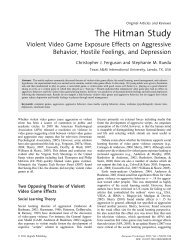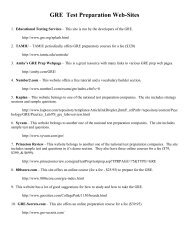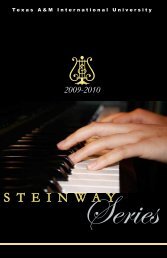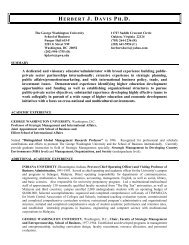Examining the validity of the modified Taylor competitive reaction ...
Examining the validity of the modified Taylor competitive reaction ...
Examining the validity of the modified Taylor competitive reaction ...
Create successful ePaper yourself
Turn your PDF publications into a flip-book with our unique Google optimized e-Paper software.
Behavioral aggression test <strong>validity</strong><br />
from expected. In o<strong>the</strong>r words, individuals who used longer durations (ostensibly<br />
indicative <strong>of</strong> aggression) were less impulsive and higher in intelligence. Although it<br />
should be noted that <strong>the</strong>se results as well do not cross <strong>the</strong> r=0.40 threshold, <strong>the</strong>y are<br />
worrisome results for <strong>the</strong> <strong>validity</strong> <strong>of</strong> <strong>the</strong> <strong>modified</strong> TCRTT duration measure.<br />
As with <strong>the</strong> first study, it was possible that male participants would show<br />
differential <strong>validity</strong> in contrast to female participants. Once again, <strong>the</strong> analysis was<br />
limited to male participants only. Results, as presented in Table 5, were actually less<br />
encouraging for male participants alone. More consistent with study 1, nei<strong>the</strong>r<br />
<strong>modified</strong> TCRTT intensity nor duration was correlated with trait aggression. The<br />
<strong>modified</strong> TCRTT maintained its mis-directed relationships with <strong>the</strong> trails executive<br />
score and verbal intelligence scores.<br />
Discussion<br />
Results from study 2 provided little encouragement for <strong>the</strong> use <strong>of</strong> <strong>the</strong> <strong>modified</strong> TCRTT<br />
as a measure <strong>of</strong> aggression. For <strong>the</strong> entire sample, <strong>the</strong> <strong>modified</strong> TCRTT interference<br />
score was related to trait aggression, but this relationship appeared to have been fueled<br />
by female participants and did not hold for young men, <strong>the</strong> population most likely to act<br />
aggressively. Modified TCRTT duration scores did correlate with trails executive score<br />
and verbal intelligence, but in <strong>the</strong> opposite direction from that which would have<br />
demonstrated good <strong>validity</strong>. Thus, <strong>the</strong> <strong>modified</strong> TCRTT cannot be said to be a measure<br />
<strong>of</strong> impulsive aggression. It may be that, for women, <strong>the</strong> <strong>modified</strong> TCRTT intensity score<br />
may tap into a construct related to aggression, <strong>competitive</strong>ness perhaps. Yet, this<br />
relationship is weak and does not hold for men.<br />
General discussion<br />
Taken toge<strong>the</strong>r, <strong>the</strong> results from study 1 and study 2 provided little support for <strong>the</strong><br />
convergent <strong>validity</strong> <strong>of</strong> <strong>the</strong> <strong>modified</strong> TCRTT as a measure <strong>of</strong> aggression. Consistently<br />
Table 5 Bivariate correlations between <strong>the</strong> TCRTT and executive/cognitive outcomes (by gender). Trails<br />
executive score = TrailsB−TrailsA. The Stroop and trails scores work at inverse with each o<strong>the</strong>r; thus, a<br />
negative correlation is expected. Results for male participants appear above <strong>the</strong> diagonal line, those for<br />
female participants appear below <strong>the</strong> diagonal line<br />
Variable 1 2 3 4 5 6<br />
1. TCRTT intensity 1.00 0.33* 0.09 0.09 0.07 −0.16<br />
2. TCRTT duration 0.12 1.00 −0.10 0.07 −0.22 0.42**<br />
3. Trait aggression 0.26 0.05 1.00 0.12 0.09 0.14<br />
4. Stroop interference −0.16 0.05 −0.12 1.00 −0.28* 0.19<br />
5. Trails executive score −0.07 −0.21 −0.11 −0.06 1.00 −0.19<br />
6. WAIS −0.09 −0.02 0.11 −0.18 −0.16 1.00<br />
*P


